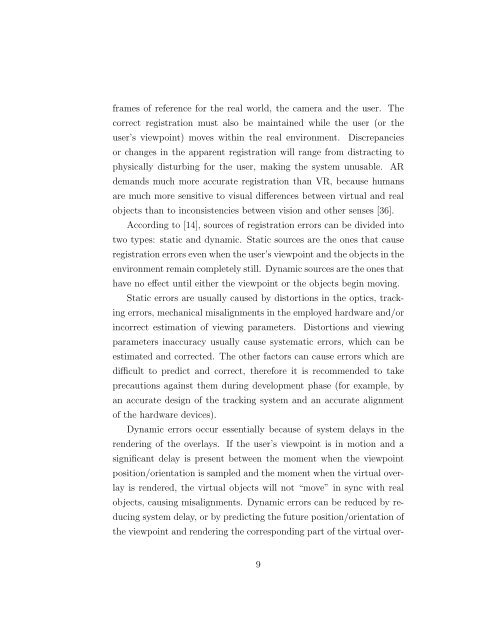Scarica (PDF – 6.19 MB)
Scarica (PDF – 6.19 MB)
Scarica (PDF – 6.19 MB)
Create successful ePaper yourself
Turn your PDF publications into a flip-book with our unique Google optimized e-Paper software.
frames of reference for the real world, the camera and the user. The<br />
correct registration must also be maintained while the user (or the<br />
user’s viewpoint) moves within the real environment. Discrepancies<br />
or changes in the apparent registration will range from distracting to<br />
physically disturbing for the user, making the system unusable. AR<br />
demands much more accurate registration than VR, because humans<br />
are much more sensitive to visual differences between virtual and real<br />
objects than to inconsistencies between vision and other senses [36].<br />
According to [14], sources of registration errors can be divided into<br />
two types: static and dynamic. Static sources are the ones that cause<br />
registration errors even when the user’s viewpoint and the objects in the<br />
environment remain completely still. Dynamic sources are the ones that<br />
have no effect until either the viewpoint or the objects begin moving.<br />
Static errors are usually caused by distortions in the optics, track-<br />
ing errors, mechanical misalignments in the employed hardware and/or<br />
incorrect estimation of viewing parameters. Distortions and viewing<br />
parameters inaccuracy usually cause systematic errors, which can be<br />
estimated and corrected. The other factors can cause errors which are<br />
difficult to predict and correct, therefore it is recommended to take<br />
precautions against them during development phase (for example, by<br />
an accurate design of the tracking system and an accurate alignment<br />
of the hardware devices).<br />
Dynamic errors occur essentially because of system delays in the<br />
rendering of the overlays. If the user’s viewpoint is in motion and a<br />
significant delay is present between the moment when the viewpoint<br />
position/orientation is sampled and the moment when the virtual over-<br />
lay is rendered, the virtual objects will not “move” in sync with real<br />
objects, causing misalignments. Dynamic errors can be reduced by re-<br />
ducing system delay, or by predicting the future position/orientation of<br />
the viewpoint and rendering the corresponding part of the virtual over-<br />
9




